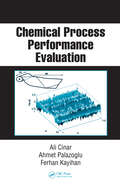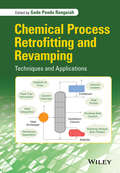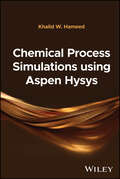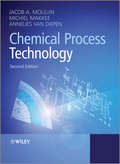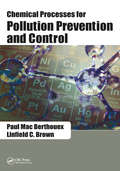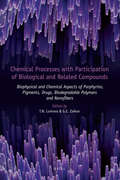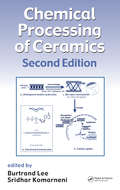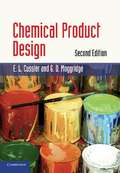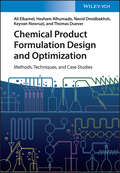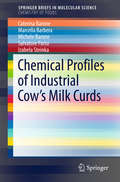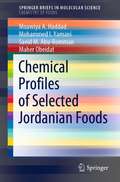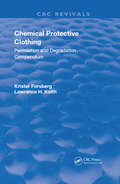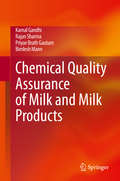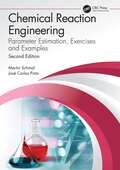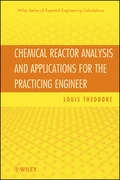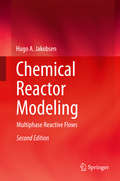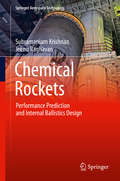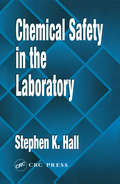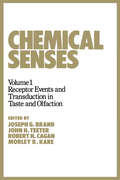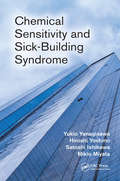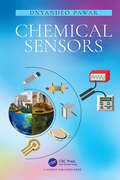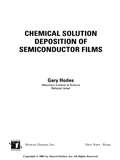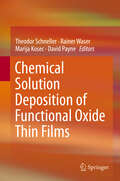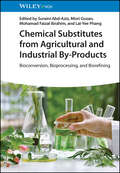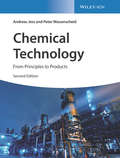- Table View
- List View
Chemical Process Performance Evaluation (Chemical Industries)
by Ali Cinar Ahmet Palazoglu Ferhan KayihanThe latest advances in process monitoring, data analysis, and control systems are increasingly useful for maintaining the safety, flexibility, and environmental compliance of industrial manufacturing operations. Focusing on continuous, multivariate processes, Chemical Process Performance Evaluation introduces statistical methods and modeling te
Chemical Process Retrofitting and Revamping
by Gade Pandu RangaiahThe proposed book will be divided into three parts. The chapters in Part I provide an overview of certain aspect of process retrofitting. The focus of Part II is on computational techniques for solving process retrofit problems. Finally, Part III addresses retrofit applications from diverse process industries. Some chapters in the book are contributed by practitioners whereas others are from academia. Hence, the book includes both new developments from research and also practical considerations. Many chapters include examples with realistic data. All these feature make the book useful to industrial engineers, researchers and students.
Chemical Process Simulations using Aspen Hysys
by Khalid W. HameedAn intuitive guide to using Aspen HYSYS for chemical, petrochemical, and petroleum industry process simulations, including interactive process flow diagrams In Chemical Process Simulations using Aspen Hysys, distinguished lecturer Dr. Khalid W. Hameed delivers an up-to-date and authoritative discussion of the simulation and design of chemical, petrochemical, and petroleum industry processes using Aspen HYSYS. The book includes coverage of many chemical engineering topics including fluid flow, reactors, unit operation of heat and mass transfer, oil refinery process, and control systems. Readers will also find highly interactive process flow diagrams for building and navigating through large simulations, as well as: A thorough introduction to the use of Aspen HYSYS for the chemical, oil, and petrochemical industriesSkill development techniques for users of Aspen HYSYS and strategies for improving the accuracy of results Practical discussions of Dynamic State Simulation with explanations of how to install control systems for the process using flash separator, gas processing, and advanced process control such as ratio control, cascade control, and split range controlIllustrative examples of Plant Wide Projects that demonstrate the ability of Aspen HYSYS to perform a full plant Perfect for research and development engineers in the fields of petrochemical, chemical, and petroleum engineering, Chemical Process Simulations using Aspen HYSYS will also benefit researchers with an interest in the area.
Chemical Process Technology
by Jacob A. Moulijn Annelies E. van Diepen Michiel MakkeeWith a focus on actual industrial processes, e.g. the production of light alkenes, synthesis gas, fine chemicals, polyethene, it encourages the reader to think "out of the box" and invent and develop novel unit operations and processes. Reflecting today's emphasis on sustainability, this edition contains new coverage of biomass as an alternative to fossil fuels, and process intensification.The second edition includes:New chapters on Process Intensification and Processes for the Conversion of BiomassUpdated and expanded chapters throughout with 35% new material overallText boxes containing case studies and examples from various different industries, e.g. synthesis loop designs, Sasol I Plant, Kaminsky catalysts, production of Ibuprofen, click chemistry, ammonia synthesis, fluid catalytic crackingQuestions throughout to stimulate debate and keep students awake!Richly illustrated chapters with improved figures and flow diagramsChemical Process Technology, Second Edition is a comprehensive introduction, linking the fundamental theory and concepts to the applied nature of the subject. It will be invaluable to students of chemical engineering, biotechnology and industrial chemistry, as well as practising chemical engineers. From reviews of the first edition:"The authors have blended process technology, chemistry and thermodynamics in an elegant manner... Overall this is a welcome addition to books on chemical technology." - The Chemist"Impressively wide-ranging and comprehensive... an excellent textbook for students, with a combination of fundamental knowledge and technology." - Chemistry in Britain (now Chemistry World)
Chemical Processes for Pollution Prevention and Control
by Paul Mac Berthouex Linfield C. BrownThis book examines how chemistry, chemical processes, and transformations are used for pollution prevention and control. Pollution prevention reduces or eliminates pollution at the source, whereas pollution control involves destroying, reducing, or managing pollutants that cannot be eliminated at the source. Applications of environmental chemistry are further illustrated by nearly 150 figures, numerous example calculations, and several case studies designed to develop analytical and problem solving skills. The book presents a variety of practical applications and is unique in its integration of pollution prevention and control, as well as air, water, and solid waste management.
Chemical Processes with Participation of Biological and Related Compounds: Biophysical and Chemical Aspects of Porphyrins, Pigments, Drugs, Biodegradable Polymers and Nanofibers
by Tatyana N. Lomova Gennady E. ZaikovThe book is devoted to kinetics and thermodynamics of the processes with participation of some biological compounds and their synthetic analogues. Aspects of their acting as model enzymes, molecular receptors, photo sensitizers, pharmocophores, and biopharmaceutical compounds are under consideration. Quantitative characteristics of transfer of cati
Chemical Processing of Ceramics
by Sridhar Komarneni Burtrand LeeMany believe that the silicon/information age is heading to the Age of Biology and that the next frontier in ceramics will most likely require molecular level or nanoscale control. What, then, is the role of ceramics in the age of biology? As we change from an energy-rich society to an energy-declining society, how can ceramic materials appease the
Chemical Product Design
by E. L. Cussler G. D. MoggridgeThe chemical industry is changing, going beyond commodity chemicals to a palette of higher value added products. This groundbreaking book, now revised and expanded, documents this change and shows how to meet the challenges implied. Presenting a four-step design process – needs, ideas, selection, manufacture – the authors supply readers with a simple design template that can be applied to a wide variety of products. Four new chapters on commodities, devices, molecules/drugs and microstructures show how this template can be applied to products including oxygen for emphysema patients, pharmaceuticals like taxol, dietary supplements like lutein, and beverages which are more satisfying. For different groups of products the authors supply both strategies for design and summaries of relevant science. Economic analysis is expanded, emphasizing the importance of speed-to-market, selling ideas to investors and an expectation of limited time in the market. Extra examples, homework problems and a solutions manual are available.
Chemical Product Formulation Design and Optimization: Methods, Techniques, and Case Studies
by Ali Elkamel Hesham Alhumade Navid Omidbakhsh Keyvan Nowruzi Thomas DueverChemical Product Formulation Design and Optimization Explore the cutting-edge in chemical product formulation and design In Chemical Product Formulation Design and Optimization: Methods, Techniques, and Case Studies, a team of renowned technologists and engineers delivers a practice guide to chemical product design. Offering real-world case studies for disinfectant formulation, the optimization of defined media, and the formulation of biocomposites, the book contains introduction to the current product design process. In addition to the background of related statistical techniques, readers will find: Clear illustrations, figures, and tables that improve understanding and retention of critical topics Thorough introductions to the mathematical principles of chemical product design A complete examination of intellectual property considerations in the chemical product design process Ideal for process and chemical engineers, Chemical Product Formulation Design and Optimization: Methods, Techniques, and Case Studies is a must-read resource for professionals in the pharmaceutical and cosmetics industry as well as chemical engineers working in the food, paint, and dye industries who seek a one-stop resource that includes the latest advances in chemical product formulation.
Chemical Profiles of Industrial Cow’s Milk Curds (SpringerBriefs in Molecular Science)
by Salvatore Parisi Caterina Barone Izabela Steinka Marcella Barbera Michele BaroneThis Brief explores the chemistry and production technology of a cheese precursor: the cow's milk curd. It explains how different coagulation and treatment methods can be used to obtain various types of cheeses. Parameters such as the type of used milk, the coagulation method, pH value, color, and microbial fermentation have a profound impact on the resulting curd properties, and hence on the cheese. The authors discuss some of the most important parameters, and how their modification can lead to a variety of cheese and dairy products. This Brief also addresses the question, if cheese makers can standardize their production procedures, and what role chemistry may play in that. Another important point addressed here are the sources of failures in the curd production, e. g. in packaging systems. Readers will find selected examples of helpful analytical techniques for studying and evaluating curd quality, and for monitoring the chemical evolution of selected chemical substances or protein aggregation.
Chemical Profiles of Selected Jordanian Foods (SpringerBriefs in Molecular Science)
by Moawiya A. Haddad Mohammed I. Yamani Maher Obeidat Saeid M. Abu-RommanThis book provides an overview of various traditional Middle Eastern food products and beverages and investigates their chemical, microbial and physical profiles. The authors selected 5 traditional Jordanian products that represent the region’s historical foods and beverages and examined them with a focus on their chemical composition and preparation, as well as features such as food safety and quality management. The first chapter provides a general introduction to traditional foods in Jordan. Subsequent chapters then shed light on specific product classes, including Shaneenah, a popular fermented dairy drink; Mujaddara and Rashoof, two products based on lentils; Kebab products; soft cheese; and Muhallabiaah, a traditional milk pudding. This book offers a valuable reference guide to many traditional/historical products in the Middle East, and due to region’s historical influence on the Mediterranean diet, it is also of interest to researchers in southern Europe.
Chemical Protective Clothing: Permeation and Degradation Compendium (Routledge Revivals)
by Krister Forsberg Lawrence H. KeithFirst Published in 1995. The three most important things to evaluate when selecting Chemical Protective Clothing (CPC) are: evidence of degradation of the garment exposed to a chemical; breakthrough time; and permeation rate. Because proper CPC selection must be based on permeation and degradation tests performed upon specific manufacturer products, an information source that enables you to access test results quickly and easily is needed. "Chemical Protective Clothing Permeation and Degradation Compendium" aims to be that source.
Chemical Quality Assurance of Milk and Milk Products
by Rajan Sharma Kamal Gandhi Priyae Brath Gautam Bimlesh MannThis book discusses quality-related aspects of milk and milk products, covering the various analytical procedures for testing the quality and composition. It also describes the adulteration of milk and milk products and the common as well as advanced techniques used to detect such adulteration. Further, the book examines food laws, guidelines and regulations laid down by FSSAI, CODEX, ISO, IDF and USFDA, and addresses the functioning of a number of international and national organizations, including the WTO, Codex Alimentarius Commission, and BIS. Familiarizing readers with the concepts of QC, TQM, PDCA cycle and related concepts of quality assurance, the book also provides information on other topics that indirectly contribute to the quality of milk and milk products, like the calibration of milk testing equipment, quality of water used in milk processing and the standardization of various chemicals used for testing. This book is a valuable resource for researchers and industry professionals dealing with dairy products.
Chemical Reaction Engineering: Parameter Estimation, Exercises and Examples
by Martin Schmal José Carlos PintoThe first English edition of this book was published in 2014. This book was originally intended for undergraduate and graduate students and had one major objective: teach the basic concepts of kinetics and reactor design. The main reason behind the book is the fact that students frequently have great difficulty to explain the basic phenomena that occur in practice. Therefore, basic concepts with examples and many exercises are presented in each topic, instead of specific projects of the industry. The main objective was to provoke students to observe kinetic phenomena and to think about them. Indeed, reactors cannot be designed and operated without knowledge of kinetics. Additionally, the empirical nature of kinetic studies is recognized in the present edition of the book. For this reason, analyses related to how experimental errors affect kinetic studies are performed and illustrated with actual data. Particularly, analytical and numerical solutions are derived to represent the uncertainties of reactant conversions in distinct scenarios and are used to analyze the quality of the obtained parameter estimates. Consequently, new topics that focus on the development of analytical and numerical procedures for more accurate description of experimental errors in reaction systems and of estimates of kinetic parameters have been included in this version of the book. Finally, kinetics requires knowledge that must be complemented and tested in the laboratory. Therefore, practical examples of reactions performed in bench and semi-pilot scales are discussed in the final chapter. This edition of the book has been organized in two parts. In the first part, a thorough discussion regarding reaction kinetics is presented. In the second part, basic equations are derived and used to represent the performances of batch and continuous ideal reactors, isothermal and non-isothermal reaction systems and homogeneous and heterogeneous reactor vessels, as illustrated with several examples and exercises. This textbook will be of great value to undergraduate and graduate students in chemical engineering as well as to graduate students in and researchers of kinetics and catalysis.
Chemical Reactor Analysis and Applications for the Practicing Engineer
by Louis TheodoreThis books format follows an applications-oriented text and serves as a training tool for individuals in education and industry involved directly, or indirectly, with chemical reactors. It addresses both technical and calculational problems in this field. While this text can be complimented with texts on chemical kinetics and/or reactor design, it also stands alone as a self-teaching aid. The first part serves as an introduction to the subject title and contains chapters dealing with history, process variables, basic operations, kinetic principles, and conversion variables. The second part of the book addresses traditional reactor analysis; chapter topics include batch, CSTRs, tubular flow reactors, plus a comparison of these classes of reactors. Part 3 keys on reactor applications that include non-ideal reactors: thermal effects, interpretation of kinetic data, and reactor design. The book concludes with other reactor topics; chapter titles include catalysis, catalytic reactors, other reactions and reactors, and ABET-related topics. An extensive Appendix is also included
Chemical Reactor Modeling: Multiphase Reactive Flows
by Hugo A. JakobsenChemical Reactor Modeling closes the gap between Chemical Reaction Engineering and Fluid Mechanics The second edition consists of two volumes: Volume 1: Fundamentals. Volume 2: Chemical Engineering Applications In volume 1 most of the fundamental theory is presented. A few numerical model simulation application examples are given to elucidate the link between theory and applications. In volume 2 the chemical reactor equipment to be modeled are described. Several engineering models are introduced and discussed. A survey of the frequently used numerical methods, algorithms and schemes is provided. A few practical engineering applications of the modeling tools are presented and discussed. The working principles of several experimental techniques employed in order to get data for model validation are outlined. The monograph is based on lectures regularly taught in the fourth and fifth years graduate courses in transport phenomena and chemical reactor modeling and in a post graduate course in modern reactor modeling at the Norwegian University of Science and Technology, Department of Chemical Engineering, Trondheim, Norway. The objective of the book is to present the fundamentals of the single-fluid and multi-fluid models for the analysis of single and multiphase reactive flows in chemical reactors with a chemical reactor engineering rather than mathematical bias. Organized into 13 chapters, it combines theoretical aspects and practical applications and covers some of the recent research in several areas of chemical reactor engineering. This book contains a survey of the modern literature in the field of chemical reactor modeling.
Chemical Rockets: Performance Prediction and Internal Ballistics Design (Springer Aerospace Technology)
by Subramaniam Krishnan Jeenu RaghavanThe purpose of this book is to discuss, at the graduate level, the methods of performance prediction for chemical rocket propulsion. A pedagogical presentation of such methods has been unavailable thus far and this text, based upon lectures, fills this gap. The first part contains the energy-minimization to calculate the propellant-combustion composition and the subsequent computation of rocket performance. While incremental analysis is for high performance solid motors, equilibrium-pressure analysis is for low performance ones. Both are detailed in the book's second part for the prediction of ignition and tail-off transients, and equilibrium operation. Computer codes, adopting the incremental analysis along with erosive burning effect, are included. The material is encouraged to be used and presented at lectures. Senior undergraduate and graduate students in universities, as well as practicing engineers and scientists in rocket industries, form the readership.
Chemical Safety in the Laboratory
by Stephen K. HallNothing is more important to an organization than the health and safety of its workers. The managerial effectiveness of any health and safety program is judged on the basis of how well it prevents injuries and ill health. Chemical Safety in the Laboratory provides a proven approach to implementing and maintaining an effective chemical safety program for laboratories in hospital, industrial, and educational settings. Based on 20 years of experience managing and auditing chemical safety programs, the author discusses the OSHA Laboratory Standard and the Chemical Hygiene Plan, provides guidelines for the effective use of personal protective equipment, and details chemical emergency planning and response procedures. He also outlines a 19-step decontamination procedure for emergency responders. Employee chemical exposure monitoring and victim handling procedures are among the other major topics covered in this essential guide.
Chemical Senses: Receptor Events and Transduction in Taste and Olfaction
by Joseph G. BrandThis book focuses on the initial biochemical and biophysical aspects of taste and olfaction. It is intended for a wide audience, both those already familiar with the chemical senses and those biochemists and neuro-biologists interested in gaining an appreciation of this rapidly expanding discipline.
Chemical Sensitivity and Sick-Building Syndrome
by Hiroshi Yoshino Mikio Miyata Satoshi Ishikawa Yukio YanagisawaWritten by multidisciplinary experts in medicine, chemistry, and architecture, this book examines chemical sensitivity (CS). In 15 chapters fitted to 15 lectures, it discusses not only the medical explanation, but also the environmental factors of this hypersensitive reaction, such as chemistry and architectural aspects. The book overviews pollution-induced diseases such as Minamata Disease. It also points out the similarity of modern hypersensitivity syndromes to historical pollution diseases from the viewpoints of not only natural scientific aspects, but also social understanding of the disease.
Chemical Sensors
by Dnyandeo Karbhari PawarChemical sensors contain two basic functions: recognition and transduction, and provide real-time information about substances rather than physical quantities. Such devices are extensively utilized for various applications in diverse fields. The book focuses on the physical, chemical, optical, and electrical working mechanisms of different types of sensors integrated with various smart nanomaterials and composites. The mesmerizing properties of numerous materials and their fruitful applications for detecting numerous chemical parameters are discussed here. The book provides recent progress in the chemical sensors field and connects materials, physics, chemistry, and engineering, and therefore, is suitable for engineers, industrial, and academic researchers.
Chemical Solution Deposition Of Semiconductor Films
by Gary HodesDiscussing specific depositions of a wide range of semiconductors and properties of the resulting films, Chemical Solution Deposition of Semiconductor Films examines the processes involved and explains the effect of various process parameters on final film and film deposition outcomes through the use of detailed examples. Supplying experimental results and practical examples, the book covers fundamental scientific principles underlying the chemical deposition process, various mechanisms involved in deposition, films of all the semiconductors deposited by this technique, and the use of semiconductor films in photovoltaics, photoelectrochemical properties, and size quantization effects.
Chemical Solution Deposition of Functional Oxide Thin Films
by David Payne Rainer Waser Theodor Schneller Marija KosecThis is the first text to cover all aspects of solution processed functional oxide thin-films. Chemical Solution Deposition (CSD) comprises all solution based thin- film deposition techniques, which involve chemical reactions of precursors during the formation of the oxide films, i. e. sol-gel type routes, metallo-organic decomposition routes, hybrid routes, etc. While the development of sol-gel type processes for optical coatings on glass by silicon dioxide and titanium dioxide dates from the mid-20th century, the first CSD derived electronic oxide thin films, such as lead zirconate titanate, were prepared in the 1980's. Since then CSD has emerged as a highly flexible and cost-effective technique for the fabrication of a very wide variety of functional oxide thin films. Application areas include, for example, integrated dielectric capacitors, ferroelectric random access memories, pyroelectric infrared detectors, piezoelectric micro-electromechanical systems, antireflective coatings, optical filters, conducting-, transparent conducting-, and superconducting layers, luminescent coatings, gas sensors, thin film solid-oxide fuel cells, and photoelectrocatalytic solar cells. In the appendix detailed "cooking recipes" for selected material systems are offered.
Chemical Substitutes from Agricultural and Industrial By-Products: Bioconversion, Bioprocessing, and Biorefining
by Suraini Abd-Aziz; Misri Gozan; Mohamad Faizal Ibrahim; Lai-Yee PhangChemical Substitutes from Agricultural and Industrial By-Products A comprehensive resource presenting different manufacturing bioprocesses of chemical substitutes, from agricultural and industrial by-products to value-added biorefinery products Chemical Substitutes from Agricultural and Industrial By-Products: Bioconversion, Bioprocessing, and Biorefining discusses the biorefinery of chemical substitutes from agricultural and industrial by-products, covering the consolidated bioconversion, bioprocessing, and downstream process of the significant chemical substitutes produced. In each chapter, the individual aspects of bioconversion, bioprocessing, and downstream process of chemical substitutes produced from selected agricultural and industrial by-products to selected chemical substitutes are discussed. The text includes helpful case studies of specific processes to aid in reader comprehension. Edited by four highly qualified academics, Chemical Substitutes from Agricultural and Industrial By-Products: Bioconversion, Bioprocessing, and Biorefining includes information on: Common substitutes for chemicals obtained from biomass of agricultural wastes and industrial by-products, including antioxidants, oleoresin, nanocarbon materials, enzymes, essential oils, bio-bleaching agents, and biosugars Alternative substitutes, including biofertilizers, cocoa butter substitutes, bio-succinic acids, furfural derivatives, levulinic acids, and cellulases Economic calculations, such as cost analysis, of different bioprocesses to analyze their feasibility in business and general industry Environmental impact analysis of chemical substitutes from agricultural and industrial by-products for a sustainable agriculture system Enabling readers to create a change in the perception of the waste agricultural biomass from waste to resource, Chemical Substitutes from Agricultural and Industrial By-Products: Bioconversion, Bioprocessing, and Biorefining is an essential resource for biotechnologists, chemists in industry, natural products chemists, process engineers, chemical engineers, and environmental chemists.
Chemical Technology: From Principles to Products (Coursesmart Ser.)
by Andreas Jess Peter WasserscheidA fully updated edition of a popular textbook covering the four disciplines of chemical technology?featuring new developments in the field Clear and thorough throughout, this textbook covers the major sub-disciplines of modern chemical technology?chemistry, thermal and mechanical unit operations, chemical reaction engineering, and general chemical technology?alongside raw materials, energy sources and detailed descriptions of 24 important industrial processes and products. It brings information on energy and raw material consumption and production data of chemicals up to date and offers not just improved and extended chapters, but completely new ones as well. This new edition of Chemical Technology: From Principles to Products features a new chapter illustrating the global economic map and its development from the 15th century until today, and another on energy consumption in human history. Chemical key technologies for a future sustainable energy system such as power-to-X and hydrogen storage are now also examined. Chapters on inorganic products, material reserves, and water consumption and resources have been extended, while another presents environmental aspects of plastic pollution and handling of plastic waste. The book also adds four important processes to its pages: production of titanium dioxide, silicon, production and chemical recycling of polytetrafluoroethylene, and fermentative synthesis of amino acids. -Provides comprehensive coverage of chemical technology?from the fundamentals to 24 of the most important processes -Intertwines the four disciplines of chemical technology: chemistry, thermal and mechanical unit operations, chemical reaction engineering and general chemical technology -Fully updated with new content on: power-to-X and hydrogen storage; inorganic products, including metals, glass, and ceramics; water consumption and pollution; and additional industrial processes -Written by authors with extensive experience in teaching the topic and helping students understand the complex concepts Chemical Technology: From Principles to Products, Second Edition is an ideal textbook for advanced students of chemical technology and will appeal to anyone in chemical engineering.
